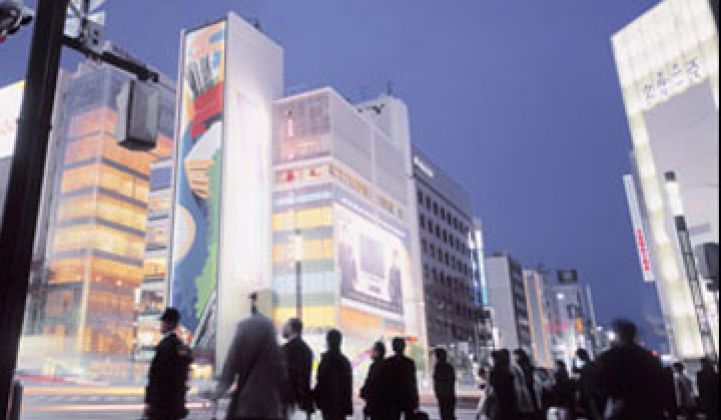China became the dominant player in solar modules in a few short years because of standardized manufacturing recipes, a diverse supply chain and high demand.
Now, several Chinese companies have begun to crank out solid state lights. Still, history may not repeat itself in exactly the same way, says Aldo Kamper, CEO of Osram Opto Semiconductors, the chip and LED division of the multibillion-dollar Osram empire, in an interview with Greentech Media.
Part of reason is epi, or the epitaxial growth of films. LEDs are built from precise layers on a sapphire substrate.
“It’s somewhat of an art. You can’t make decent stuff without epitaxial active layers,” he said. “Every machine has its own identity. You need R&D."
“There is still a technology gap and a large quality gap,” Kamper added. “It is not so easy to catch up.”
The technology gap, in fact, has already emerged on a few occasions, he said. Kamper says he has heard of some cities and agencies in China swapping out Chinese-made streetlights for lights from more established manufacturers because of technical issues.
Some Chinese fixture vendors, in fact, have begun to advertise that their lamps employ LEDs from Osram and other vendors as a selling point. “For them, that is the badge of quality that they can go to their local government with,” he said.
How the LED story plays out in China is perhaps the most crucial question facing the solid state lighting industry. The solar industry didn’t expect to be colonized quickly, but factory equipment makers and suppliers helped eliminate a lot of the mystery in the industry. China’s remarkable pipeline of grad students and scientific talent, a crucial ingredient in its rise in solar, will likely come in handy in lighting, too.
Other things on Kamper’s mind:
--Supply is rising. “Last year and the year before, there were some shortages, but that is easing up,” he said. “With the aggressive nature of the investments that we and others are taking I would not see a shortage of supply.”
Osram is doubling capacity in Malaysia right now.
--The consumer market will likely take off quicker than the commercial market. Several manufacturers are coming out with lower-priced 60- and 40- watt equivalent bulbs and many governments -- U.S., EU, Australia -- have passed regulations to encourage adoption. By contrast, inserting LEDs into commercial buildings requires some degree of retrofitting or new construction.
”Over the long term, that [commercial space] will be the main marketplace,” he said.
General lighting, though, still constitutes a small part of the total pie. LCD TVs and monitors are now probably the largest markets, recently edging past mobile.
--One of the big fears could be poor word-of-mouth reviews in the consumer market. LED bulbs from legitimate manufacturers cost $20 or $30 or more. Consumers, naturally, will often gravitate toward cheaper bulbs. If they don’t emit enough light, or emit a poor quality of light, it could become a black mark for the entire industry.
The price tag quandary might be less of an issue in the commercial market. Commercial buildings have facilities managers that will look at ROI, maintenance issues and other factors.
“In the professional market, lighting becomes an asset. You invest money and get a reduced energy bill,” he said. “It used to not be of much interest.”
--On the technological front, one of the big shifts will revolve around moving from producing LEDs on four-inch-diameter wafers, the current standard, to popping them out on six-inch wafers. A wafer would sport 2.25 times the surface area for making chips (think of the formula 'pi r squared'), which has the practical effect of doubling factory capacity.
Osram led the shift from two-inch to four-inch wafers approximately six years ago.
--Long-term, the company (among others such as Bridgelux) is looking at the prospect of swapping out sapphire for cheaper silicon. Silicon is not a very good light emitter. However, if silicon-based LEDs can become possible, the industry could shift to eight or 12 inch wafers, the standard now in semiconductors.
“It is hard to imagine that sapphire gets that big,” he said.
--Osram will concentrate on improving the efficiency of its phosphors and the overall output of light. Europeans and North Americans prefer warm white light while Asian consumers prefer cool white. (Warm white is more yellow while cool has a blue hint.)
Unfortunately, cool white bulbs emit about 30 percent more light than warm ones. Current cool whites emit around 140 to 160 lumens per watt. Theoretically, the maximum for cool whites is around 240 to 260 lumens per watt while warm whites might top out at 200 to 220 lumens per watt.
“Cooler white is more efficient. It has to do with the physics of the phosphor itself,” he said. “It will never be zero, but we will try to narrow the gap.”
Side note: Intematix has come up with a line of easy-to-adapt phosphors that could reduce stocking and inventory costs.
--Another area of innovation: heat sinks. LED light does not emit heat, but the LED chip itself does. Generally, manufacturers dissipate the warmth with fins and heat sinks.
“But metal is expensive nowadays,” he said. Boosting lumens per watt will help, but other solutions are in the works.



